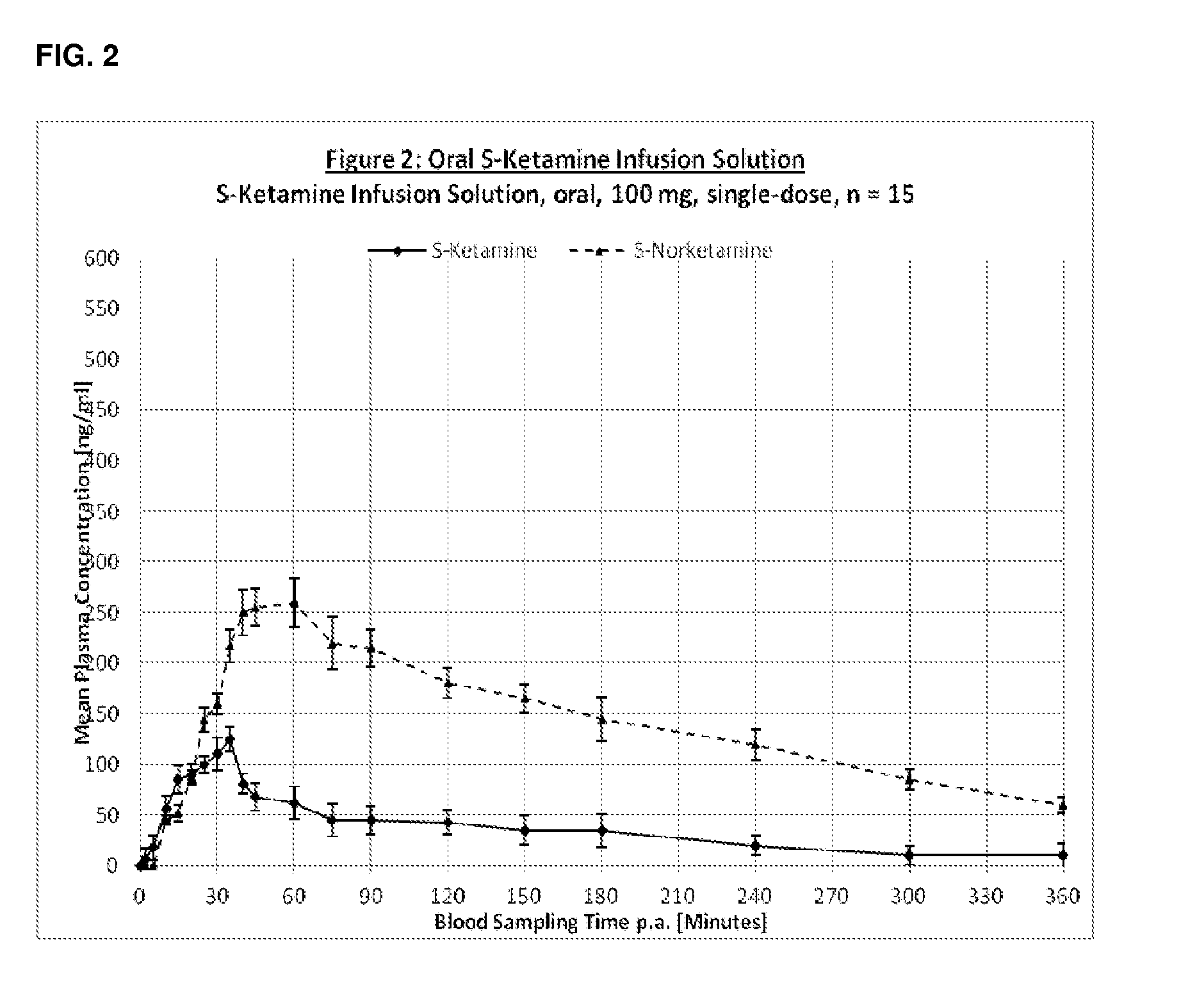Oral transmucosal adminstration forms of s-ketamine
a technology of s-ketamine and administration form, which is applied in the field of oral transmucosal administration form of s-ketamine, can solve the problems of patients suffering patients may also experience transient exacerbations of significant and severe pain, and pain has significant consequences for individual patients, their caregivers and the healthcare system. , to achieve the effect of enhancing connection, increasing heart rate, and increasing energy
- Summary
- Abstract
- Description
- Claims
- Application Information
AI Technical Summary
Benefits of technology
Problems solved by technology
Method used
Image
Examples
example 1
Pharmacokinetics (PK) of S-Ketamine Pharmaceutical Formulations
[0268]The following pharmaceutical formulations of S-Ketamine were tested:[0269]1. S-Ketamine Infusion Solution i.v.[0270]2. S-Ketamine Infusion Solution oral[0271]3. S-Ketamine Orodispersible Tablet (ODT)[0272]4. S-Ketamine Thin Layer Film[0273]5. S-Ketamine Buccal Mucoadhesive Tablets
Study Design:
[0274]Open randomized, 5-way cross-over study in 15 healthy volunteers to assess and compare the Pharmacokinetics of S-Ketamine Infusion Solution i.v., S-Ketamine Infusion Solution oral, S-Ketamine Orodispersible Tablets (ODT), S-Ketamine Thin Layer Film, and S-Ketamine Buccal Mucoadhesive Tablets.
[0275]Treatment group 1: (the active reference drug): INTRAVENOUS 100 mg S-ketamine given by infusion pump over 30 minutes. PK measurements for 6-h.
[0276]Treatment group 2: ORAL 100 mg S-ketamine injection solution with lemonade (total volume 100 ml), PK measurements for 6-h.
[0277]Treatment group 3: ORAL TRANSMUCOSAL 100 mg S-ketamin...
example 2
CRPS-1 Pain—Treatment with S-Ketamine Thin Layer Film-100 Mg
[0300]One patient (male, age 67 years) and eligible for this clinical case was diagnosed with CRPS-1 in both arms, as based on the international Association for the study of Pain CRPS-1 criteria. The patient reported pain scores of 5 or higher (on a numerical rating scale (NRS) from 0 to 10, where 0=no pain and 10=worst pain). Exclusion criteria included age<18 years, inability to give informed consent, serious medical disease (e.g., cardiovascular, renal, or liver disease), use of strong opioids or baclofen, pregnancy / lactation, and history of psychosis. The patient was asked not to change his pain medication from the start of the clinical case study until completion of follow up.
Treatment:
[0301]S-ketamine Thin Layer Film, 100 mg S-ketamine was administered twice for one day at 8:00 h and 20:00 pm).
Measurements:
[0302]The primary outcome measure of the study was pain relief as measured by the 11-point NRS ranging from 0 (no...
example 3
Spontaneous Fibromyalgia Pain—Treatment with S-Ketamine Buccal Mucoadhesive Tablet (100 mg)
[0323]One patient (female, age 66) eligible for this clinical case was diagnosed with Fibromyalgia syndrome as based on the 1990 “American College of Rheumatology” criteria: presence of widespread pain and tenderness in at least 11 of 18 tender points on specific muscle-tendon sites, age 18-75 years, spontaneous pain score of 5 or greater, and who had pain scores of 5 or higher based on a numerical rating scale (NRS) from 0 to 10, where 0=no pain and 10=worst pain).
[0324]Exclusion criteria included age<18 years, inability to give informed consent, serious medical disease (e.g., cardiovascular, renal, or liver disease), use of strong opioids or baclofen, pregnancy / lactation, and history of psychosis. The patient was asked not to change her pain medication from the start of the clinical case study until completion of follow up.
Treatment:
[0325]The treatment consisted of a single dose of 100 mg S-...
PUM
 Login to View More
Login to View More Abstract
Description
Claims
Application Information
 Login to View More
Login to View More - R&D
- Intellectual Property
- Life Sciences
- Materials
- Tech Scout
- Unparalleled Data Quality
- Higher Quality Content
- 60% Fewer Hallucinations
Browse by: Latest US Patents, China's latest patents, Technical Efficacy Thesaurus, Application Domain, Technology Topic, Popular Technical Reports.
© 2025 PatSnap. All rights reserved.Legal|Privacy policy|Modern Slavery Act Transparency Statement|Sitemap|About US| Contact US: help@patsnap.com



